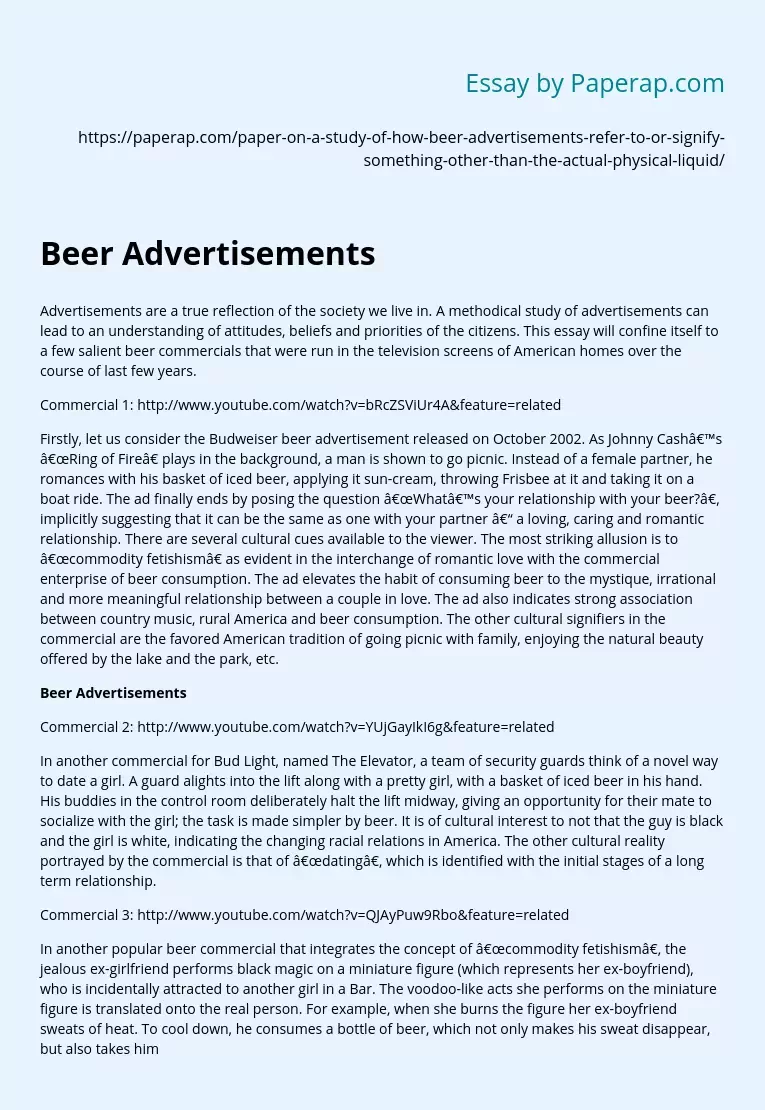Beer Advertisements
Advertisements are a true reflection of the society we live in. A methodical study of advertisements can lead to an understanding of attitudes, beliefs and priorities of the citizens. This essay will confine itself to a few salient beer commercials that were run in the television screens of American homes over the course of last few years.
Commercial 1: http://www.youtube.com/watch?v=bRcZSViUr4A&feature=related
Firstly, let us consider the Budweiser beer advertisement released on October 2002. As Johnny Cash’s “Ring of Fire” plays in the background, a man is shown to go picnic.
Instead of a female partner, he romances with his basket of iced beer, applying it sun-cream, throwing Frisbee at it and taking it on a boat ride. The ad finally ends by posing the question “What’s your relationship with your beer?”, implicitly suggesting that it can be the same as one with your partner – a loving, caring and romantic relationship. There are several cultural cues available to the viewer.
The most striking allusion is to “commodity fetishism” as evident in the interchange of romantic love with the commercial enterprise of beer consumption. The ad elevates the habit of consuming beer to the mystique, irrational and more meaningful relationship between a couple in love. The ad also indicates strong association between country music, rural America and beer consumption. The other cultural signifiers in the commercial are the favored American tradition of going picnic with family, enjoying the natural beauty offered by the lake and the park, etc.
Beer Advertisements
Commercial 2: http://www.youtube.com/watch?v=YUjGayIkI6g&feature=related
In another commercial for Bud Light, named The Elevator, a team of security guards think of a novel way to date a girl. A guard alights into the lift along with a pretty girl, with a basket of iced beer in his hand. His buddies in the control room deliberately halt the lift midway, giving an opportunity for their mate to socialize with the girl; the task is made simpler by beer. It is of cultural interest to not that the guy is black and the girl is white, indicating the changing racial relations in America. The other cultural reality portrayed by the commercial is that of “dating”, which is identified with the initial stages of a long term relationship.
Commercial 3: http://www.youtube.com/watch?v=QJAyPuw9Rbo&feature=related
In another popular beer commercial that integrates the concept of “commodity fetishism”, the jealous ex-girlfriend performs black magic on a miniature figure (which represents her ex-boyfriend), who is incidentally attracted to another girl in a Bar. The voodoo-like acts she performs on the miniature figure is translated onto the real person. For example, when she burns the figure her ex-boyfriend sweats of heat. To cool down, he consumes a bottle of beer, which not only makes his sweat disappear, but also takes him to the toilet. When he relieves himself there, the miniature doll darts liquid onto the lighter held by the ex-girlfriend, thereby putting it off. From popular culture point of view, this ad is again targeted at male audiences, suggesting to them that a beer can get rid of girl trouble, which betrays a sexist attitude among American men. All the three ads discussed were essentially targeted at men, suggesting to them that a beer can either get them a girl, get rid of their girl-trouble or play a substitute role of a girl; all of which are demeaning to women. In all the three ads, women are objectified and treated as sex-objects, representing the narrow-minded attitude toward women exhibited by most American men. Surely, feminists will find these advertisements very offensive and feel that the status of women in America has not improved a lot, even after the civil rights movement of the 1960s.
References:
Commercial 1: http://www.youtube.com/watch?v=bRcZSViUr4A&feature=related
Commercial 2: http://www.youtube.com/watch?v=YUjGayIkI6g&feature=related
Commercial 3: http://www.youtube.com/watch?v=QJAyPuw9Rbo&feature=related
Advertisements are a true reflection of the society we live in. A methodical study of advertisements can lead to an understanding of attitudes, beliefs and priorities of the citizens. This essay will confine itself to a few salient beer commercials that were run in the television screens of American homes over the course of last few years.
Commercial 1: http://www.youtube.com/watch?v=bRcZSViUr4A&feature=related
Firstly, let us consider the Budweiser beer advertisement released on October 2002. As Johnny Cash’s .
Beer Advertisements. (2019, Dec 05). Retrieved from https://paperap.com/paper-on-a-study-of-how-beer-advertisements-refer-to-or-signify-something-other-than-the-actual-physical-liquid/

